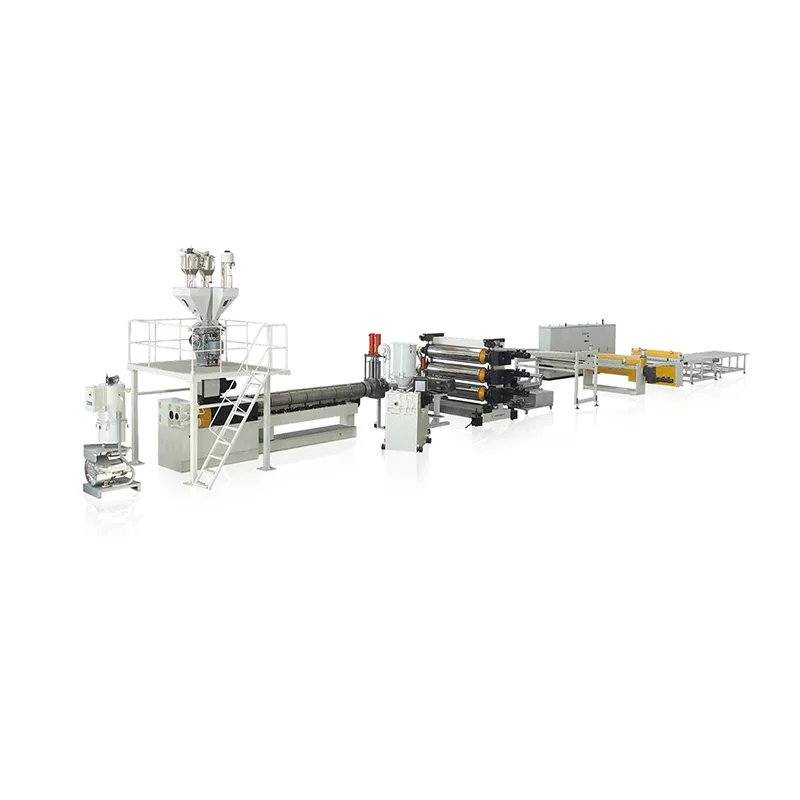- This topic is empty.
-
AuthorPosts
-
2025-10-30 at 3:54 pm #10695
In modern plastic processing industries, the multi-layer plate extrusion line has become an indispensable manufacturing system. It enables the precise production of high-quality composite sheets that meet the diverse needs of automotive, appliance, and sanitaryware sectors. By integrating advanced co-extrusion technology, optimized temperature control, and intelligent automation, this extrusion line ensures excellent mechanical strength, visual appearance, and processing stability across different polymer combinations such as ABS, PC, HIPS, GPPS, and PMMA. In this blog post, Suzhou Jwell Machinery, a high performance jwell extruder provider, will share the features of multi-layer plate extrusion line for high quality plastic sheets.
Multi-Layer Plate Extrusion Line: Core Process and Structure
The multi-layer plate extrusion line is designed to produce composite sheets consisting of two or more polymer layers, each contributing distinct physical or aesthetic properties. The line typically includes a main extruder, co-extruders, a feed block or co-extrusion die, a three-roll calender system, a cooling unit, and a take-up device.
The main extruder handles the base polymer, while auxiliary extruders feed additional functional layers—such as surface gloss, impact resistance, or UV protection. The co-extrusion die head ensures uniform flow distribution across all layers, maintaining consistent thickness and adhesion. Finally, the calendering rolls form the sheet with desired texture and gloss level, achieving precise control over surface quality.
This combination of mechanical precision and intelligent control allows manufacturers to produce sheets with exceptional consistency and repeatability, meeting stringent industrial and aesthetic standards.

ABS and HIPS/GPPS Refrigerator Board Extrusion Line
One of the key applications of the multi-layer sheet extrusion line lies in producing ABS and HIPS/GPPS refrigerator boards. These materials are widely used in refrigerator doors, inner liners, drawers, and water dispenser panels.
The ABS layer provides toughness and thermal stability, while the HIPS or GPPS layer ensures high surface gloss and ease of thermoforming. Together, these layers create a composite plate that is both durable and visually appealing.
The production process emphasizes excellent adhesion between layers, controlled cooling, and surface flatness. The result is a refrigerator board that resists cracking, maintains color stability under low temperatures, and meets hygiene standards required for household and commercial refrigeration systems.
ABS/PMMA Sanitaryware Plate Production
Another critical application of the multi-layer plastic plate extrusion line is the production of ABS/PMMA sanitaryware sheets. These composite plates are widely used in bath products, including bathtubs, shower enclosures, steam rooms, and wash basins.
In this configuration, PMMA (Acrylic) serves as the surface layer, providing a glossy, scratch-resistant, and easy-to-clean finish, while ABS acts as the structural backing, offering impact resistance and mechanical support.
The extrusion and co-extrusion parameters are finely tuned to prevent internal stress and maintain transparency or high surface gloss. The sheets exhibit excellent formability during vacuum forming, allowing for intricate shapes and designs. Moreover, the multi-layer structure ensures that sanitaryware products retain their appearance and mechanical integrity even after long-term exposure to humidity and temperature variations.
ABS/PC Baggage Plate Extrusion Line
The ABS/PC composite plate extrusion line is tailored for the production of high-strength baggage plates used in draw-bar boxes, luggage cases, and recreation bags. Combining ABS (Acrylonitrile Butadiene Styrene) and PC (Polycarbonate) results in sheets that exhibit both rigidity and toughness, making them ideal for handling the stresses of travel and transport.
The multi-layer extrusion system enables uniform bonding of layers with precise control of thickness and optical properties. The co-extruded plates can be easily thermoformed into luggage shells with excellent dimensional accuracy, surface quality, and resistance to impact and deformation.
Additionally, the use of automated temperature and pressure control systems during extrusion ensures that the finished plates maintain stable performance under varying production conditions. This technology is especially valuable for manufacturers aiming to balance lightweight design with durability and aesthetics.
Automotive ABS and ABS+PC Composite Plate Line
In the automotive industry, the multi-layer co-extrusion line is essential for producing ABS and ABS+PC car plates. These materials are commonly used for vehicle rooftops, dashboards, door panels, backrests, motorcycle shells, and golf car components.
The combination of ABS and PC offers an excellent balance of heat resistance, rigidity, and impact strength. Moreover, the plates can be surface-treated or laminated for decorative or functional enhancement, such as UV protection or texture embossing.
Automotive-grade extrusion lines often incorporate advanced automation systems with real-time monitoring and feedback control. These systems ensure uniform melt flow, accurate layer thickness, and minimal material waste. The final product meets the high performance and safety requirements demanded by the modern transportation industry, while also allowing flexibility in color, texture, and design customization.
Intelligent Control and Sustainable Manufacturing
Modern multi-layer extrusion lines integrate intelligent control systems and energy-efficient technologies. With the implementation of PLC-based automation and human-machine interfaces (HMI), operators can monitor temperature, pressure, and flow rate in real time, optimizing production efficiency.
Furthermore, the use of energy recovery systems and precision cooling technologies contributes to sustainability by minimizing energy consumption and material waste. The extrusion line’s modular design also facilitates rapid material changeovers, helping manufacturers adapt to different product categories with minimal downtime.
As the demand for customized plastic plates continues to rise across industries—from consumer appliances to automotive interiors—the multi-layer plate extrusion line stands as a core solution for achieving high-performance, multi-functional composite materials with stable and efficient production.
Conclusion
The multi-layer plate extrusion line represents the convergence of engineering precision, materials science, and industrial automation. Whether producing ABS/HIPS refrigerator boards, ABS/PMMA sanitaryware plates, ABS/PC luggage sheets, or ABS+PC automotive panels, this advanced system delivers consistent quality and adaptability to evolving industrial needs.
With its capability to combine multiple polymer properties into one cohesive sheet, the technology continues to drive innovation in product design, manufacturing efficiency, and sustainable production practices—ensuring its central role in the future of modern polymer processing.
http://www.jwellplas.com
Jwell Machinery -
AuthorPosts
- You must be logged in to reply to this topic.